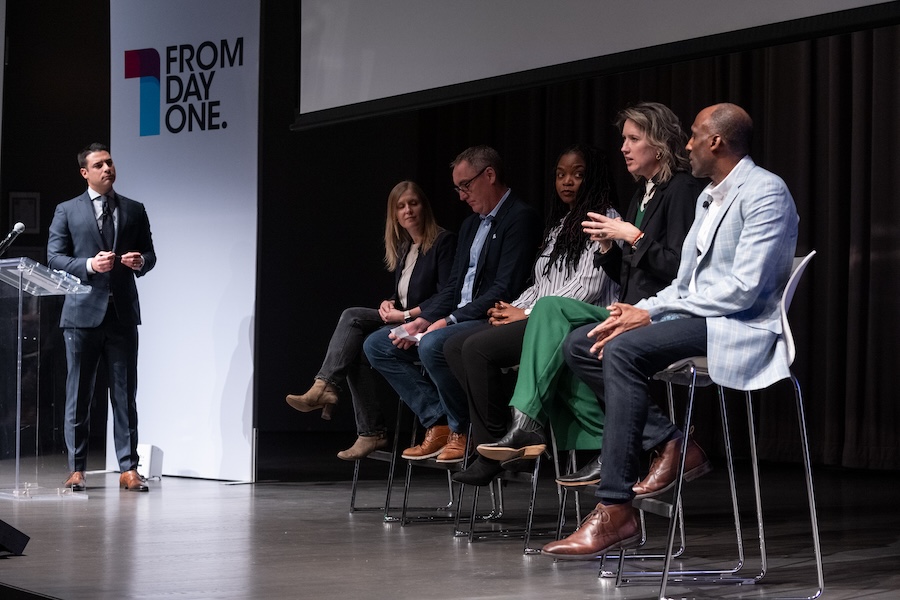Manager Effectiveness: Defining It, Measuring It, and Improving It


Companies frequently promote employees to management positions because of their technical skills but find they need help with leading people.
When they were in their previous roles, these individuals thrived because they had the correct answers, says Gretchen Jacobi, SVP and head of enterprise at General Assembly. Jacobi spoke on a panel about “Manager Effectiveness: Defining It, Measuring It, and Improving It” at From Day One’s Chicago conference.
Once you’re in a leadership role, “it’s about how you guide your team to find the right answer, as opposed to giving them the right answer,” she told moderator Alex Maragos, anchor and reporter at NBC 5 News. “I think we need to focus on helping managers define the outcome they want from the team rather than telling their team how to achieve the outcome.”
Preparing employees to become leaders is the key to their success, says Nicole Poole-McGill, senior VP for talent development for Digitas North America.
“I’ve been in positions where we had the opportunity to prepare managers, or we saw that potential and their interest, and then put them in positions to manage people before they became managers,” she said. “It’s so helpful for them to come in just having some of that skill and getting the training so they can apply it as soon as they become managers.”
New managers need specialized training in giving feedback and communication styles, says Poole-McGill. She also said one-on-one coaching can help them build relationships with their team and manage their performance.
How to Measure Management Effectiveness
An organization’s culture plays a key role in how it measures the effectiveness of its managers, says Steve Holder, VP of solution advisory at Visier. “Different management skills, different attributes and different measurements are going to be driven by what your organization thinks is important,” he said.
Visier builds manager effectiveness scorecards and dashboards that allow people to not only measure their peers, but also understand what they’re doing, says Holder. “The big one that always comes up is retention,” he said. “That’s a really easy one to throw on your management effectiveness card.”

Diversity is a frequently overlooked metric for measuring management effectiveness, says Holder. “We know that diverse teams have better outcomes, productivity and collaboration," he said.
Jaison Williams, the senior VP of talent management capabilities and culture for Expedia, says it’s crucial to understand how performance and productivity go hand in hand.
“We’ve taken a look at how much we are spending in meetings as an organization,” he said. “We’ve been able to identify that we spend a large amount of time in meetings overall. And then similarly, we have found that people are collaborating and engaging with way too many people.”
As a manager, “you are probably role modeling some of that behavior,” Williams said. “But being able to make a concrete change in how and where your team is spending its time using some type of business and organizational data can lead to much stronger manager effectiveness and organizational effectiveness.”
Improving Manager Effectiveness
The manager of a team is much like a basketball coach, says Kristy Callahan, who leads the learning and development team at GE Healthcare.
“If you figure out how to tap into the strengths of each individual, how do you string that together to make that collective pool stronger?” she said. Every player on a winning basketball team might not be a star, “but together they are bringing out the best in each other.”
When there’s one outstanding player on a team, "How do you bring others up?" she said. “What is it that we all bring? We all have our superpowers. How do we tap into that?"
Only 31% of managers have experienced formal development for upskilling or reskilling, says Jacobi. “The people who are now reporting to them need to make time for synchronous or asynchronous training opportunities that are going to make them more productive.”
Managers must be clear that they are on a learning journey themselves, says Jacobi. “They are role models for the people below them,” she said.
Being an effective manager is challenging in a hybrid workplace, says Poole-McGill. When employees were in the office all the time, connections occurred naturally as they gathered around the water cooler and chatted about their lives outside of work.
With so many employees working from home at least part of the time, it’s harder to build connections. It’s possible to revive that sense of connection in a hybrid workplace, “but you have to be very intentional about that, and even strategic.”
Williams said he finds it easy to connect with his direct reports as a senior leader, but his extended team, which is spread worldwide, is a different matter. Connectivity in the hybrid remote world is all about creativity. His executive assistant developed the concept of ‘Cups and Conversations With Jaison.’ “Once a month, she just blocks out my whole day and asks people on the team to sign up. It’s just a casual conversation about whatever you want,” he said.
Mary Pieper is a freelance writer based in Mason City, Iowa.
The From Day One Newsletter is a monthly roundup of articles, features, and editorials on innovative ways for companies to forge stronger relationships with their employees, customers, and communities.